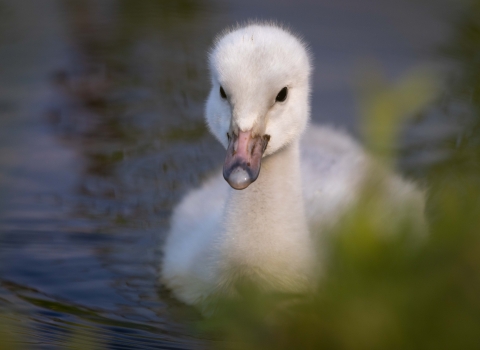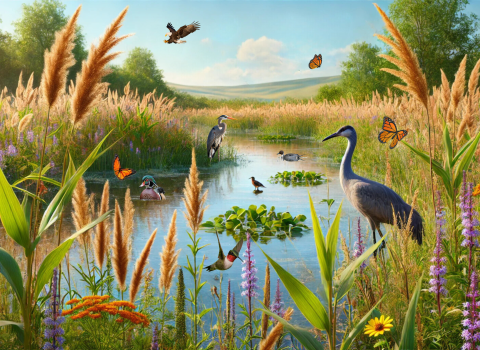Beale Air Force Base is known for its fast jets and top pilots, but it’s gaining recognition as a home for monarch butterflies. While the butterfly’s population has been declining across the nation, hundreds have been observed stopping to rest at Beale as they travel from their winter home on California’s coast to warmer areas to lay eggs. To support the butterflies’ long journey, Beale has built pollinator gardens that provide essential food and habitat.
“Monarch butterfly populations have declined significantly over the past two decades,” said Cathy Johnson, a scientist in the U.S. Fish and Wildlife Service’s Sacramento Field Office. In addition to serving as the liaison to Beale, Johnson worked extensively on the Service’s national pollinator recovery efforts. “When partners like Beale want to build habitat, we provide all the help we can.”
Easily recognized by its striking orange and black wings, the monarch butterfly is dependent on milkweed for survival. It will feed from a number of plants, but monarchs only lay its eggs on milkweed. When the caterpillars hatch, they solely feed on milkweed until morphing into butterflies in the late summer. Unfortunately, habitat fragmentation and pesticides are impacting the availability of milkweed across the monarch’s range.
Chadwick McCready, a biologist who has worked at Beale for more than five years, reached out to Johnson after observing monarchs and their larvae on the base. He spotted the butterflies congregating in low drainages in the morning and then moving under the shade of the oak trees in the afternoon. What started as an observation and a riparian riparian
Definition of riparian habitat or riparian areas.
Learn more about riparian restoration project led to the discovery of 10 monarch breeding sites on Beale, an unusual find in the Central Valley.
“Beale AFB has large areas of undeveloped habitat available, including seasonal drainages that provide all the resources monarchs need to reproduce and continue their migration during the summer and early fall months. These resources are shade, roosting sites, water, milkweed and nectar resources,” said McCready.
In 2017, McCready built the first pollinator garden on the base to support the monarchs using all native plants. Since then, the original garden has expanded to nearly an acre in size and two more gardens are underway. McCready’s pollinator gardens contain rows of native shrubs with milkweed interspersed throughout. Not only does this planting method suppress weeds naturally, the structure structure
Something temporarily or permanently constructed, built, or placed; and constructed of natural or manufactured parts including, but not limited to, a building, shed, cabin, porch, bridge, walkway, stair steps, sign, landing, platform, dock, rack, fence, telecommunication device, antennae, fish cleaning table, satellite dish/mount, or well head.
Learn more about structure provides coverage and shelter for the butterflies and other native wildlife, including snakes, quail and lizards.
“The monarchs start arriving in March and leave just before Halloween,” said McCready. “To make sure they have food during their stay and energy for their journey back to their overwintering sites, our pollinator gardens contain a variety of native plants that flower at different times during those months.”
While they aren’t incredibly colorful, native plants in McCready’s pollinator gardens include creeping sage, which blooms in the early summer, and buckwheat, which blooms through the summer. Shrubs, such as coyote bush and rabbit bush, bloom in the fall. As for milkweed, the gardens contain three species that grow wild on the base, including woolypod (Asclepias eriocarpa), showy (A. speciosa) and narrowleaf milkweed (A. fascicularis).
“There’s enough milkweed diversity on Beale for the monarchs to stay the entire breeding season,” said McCready.
One of the most valuable lessons McCready learned during this effort is that everyone can play a role in this species’ survival and recovery. “Monarchs are migratory, so everyone along their path can give them resources to make migration possible. Every milkweed plant or native flowering plant helps.”
McCready and his team plan to start surveying the monarch numbers on Beale this year. The hope is that the numbers will increase every year.
Johnson thinks Beale’s work shows a lot of promise and gives her hope. “Beale’s work is helping to raise awareness of pollinators and the role they play in the cycle of life. Thirty-five percent of the crop-based food we eat is dependent on pollinators, so supporting their recovery is essential to our survival.”
Do you want to build pollinator habitat in your yard to help monarchs? Here are some of McCready’s tips:
- Make sure you use milkweed that’s native to your region of California. There are more than 20 varieties of milkweed in California and many others throughout the country. McCready has found good success with Showy milkweed, woolypod milkweed and narrowleaf milkweed on the base.
- Use native plants that vary in size and purpose. Successful pollinator gardens have plants with big flowers for feeding, as well as shrubs or willow trees for roosting, shade and overnight shelter.
- Use native plants that deer avoid and have staggered blooming periods. McCready recommends coyote bush, rabbit bush, creeping sage and different buckwheats to ensure a good food supply for the monarch from March until October.
- Make sure you have a water source nearby. Native plants often take a year to establish before they can survive without human help, so they will need water throughout the summer.
- Don’t use pesticides. Try planting more delicate plants, like milkweed, between shrubs to control weeds instead.



